Pam asked: How can I wash dark clothing and still kill pathogens? I work in a hospital where I must wear a dark blue lab coat and dark pants. The spores from harmful pathogens are on my clothing after work. Is there any way to kill these pathogens on dark clothing that cannot be bleached nor washed in hot water?
Laundry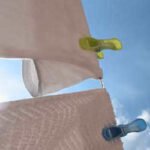 and other linens can harbor bacteria that can cause an illness to return or spread. Here is some information to help you clean your colored clothes or other items more effectively when needed without the use of chlorine bleach. However, these methods are for general disinfecting purposes. If you have a specific illness or are disinfecting after a flood, contact the CDC for specific information you may need.
and other linens can harbor bacteria that can cause an illness to return or spread. Here is some information to help you clean your colored clothes or other items more effectively when needed without the use of chlorine bleach. However, these methods are for general disinfecting purposes. If you have a specific illness or are disinfecting after a flood, contact the CDC for specific information you may need.
Using Household Items
Although the products listed below are not EPA registered disinfectants, they do help to disinfect. If you want to give your laundry an extra cleansing boost or if you just need items in a pinch that you already have at home, use one or more of these tips.
- To use white vinegar, add 1 cup of it to the rinse cycle. This is very effective for killing bacteria, and will also help to deodorize laundry (which is a good sign that odor-causing bacteria has been killed). It is also an effective fabric softener, and helps to keep colors bright.
- To use hydrogen peroxide, add 1 cup of 3% hydrogen peroxide to the wash. Be sure to spot test the peroxide first though as it can have a bleaching effect on some fabrics.
- Borax can be used in addition to your regular detergent. It is especially effective as an antifungal, but also helps as a disinfectant.
- Oxygen bleach does disinfect, though it is not as strong of a disinfectant as chlorine bleach. Use an oxygen laundry detergent, such as OxiClean, to help disinfect your clothes more than a regular detergent would.
- Pine oil is very effective at disinfecting. The greater the amount of pine oil in a product, the better it will clean. Add one cup of a pine oil product to the wash, such as Pine Sol or Olde Tyme Super Pine Cleaner. This should not be used on silk or wool. Keep in mind that the pine odor may remain after washing, and it also can be very allergenic. Running a second rinse cycle can help to remove any remaining residue. Also, use caution with this if you have cats as pine oil is toxic to them.
- Sunlight is extremely sanitizing, so if you can line dry your laundry in the sun, that will give it an extra disinfecting boost. If you can’t hang your laundry in the sun, there are UV wands you can get for sanitizing. See our guide How to Clean with UV Light for more information. Keep in mind that regular or extended time in the sun can cause fading. If the item is already dry, about 30 minutes in the sun (on each side) is enough to kill surface bacteria.
Using Laundry Products
There are some laundry detergents available that boast about their germ-killing prowess. If you need to disinfect laundry often, these are products you should consider.
- Hog Farm Laundry Soap Solids is an EPA registered disinfectant. However, the solid tablets should not be used in HE washers. They also make a powdered version, which they say is “not yet certified” as an EPA registered disinfectant, but contains the same germ-killing ingredients. Learn more here.
- Lysol Laundry Sanitizer advertises that it kills 99.9% of bacteria. Learn more here. However, one of our site users (Thanks Jan!) commented below that Lysol may be dangerous to cats, so use caution when considering this option for pet bedding items or any other linens your cat regularly uses. Also, the label states that this product should be added to the rinse cycle and allowed to stay there for 16 minutes, so consider if your washer is able to be paused on the rinse cycle or how long your rinse cycle lasts.
- Hunter’s Edge Silver Laundry Detergent contains silver, which can kill bacteria. Learn more here.
- Defense Super Shield Laundry Additive is advertised as helping to protect against microbes, including bacteria and fungus, that fabrics may encounter in the future.
- Consider using Dr. Bronner’s Castile Soaps or Sal Suds in place of your regular laundry detergent. They are all natural and are incredibly effective as a soap. They also contain essential oils, which have disinfecting properties. Be sure to use a product that does not contain essential oils for use on pet bedding as many are toxic to dogs and/or cats.
Using Essential Oils
Essential oils have a variety of pathogen-fighting powers, from being antibacterial or antifungal to being antiseptic (preventing the growth of bacteria in the future). They also can add a pleasant scent to your laundry. Select one or more of the essential oils below to include in your laundry, then wash and dry the clothes using normal cycles. Use caution if you have pets in your home however, as essential oils can be toxic to them. Also use caution if you are pregnant. It is best to avoid the use of essential oils on children’s laundry, especially tea tree oil.
- Tea tree oil is effective in disinfecting, but check the labels carefully. Be sure the product you purchase is a high quality, 100% tea tree oil, not a bargain mixture. Add 2 teaspoons of tea tree oil to each load.
- Lavender oil is antibacterial and antiseptic, as well as antifungal. Add 10 drops to each load.
- Thyme oil is a powerful disinfectant known to kill E. coli and MRSA, and is also an antifungal. Only get a thyme oil that is twice distilled to be sure its irritants have been removed. Do not use this oil if you are pregnant. Add 1/2 to 1 teaspoon of it to each load.
Using Heat to Sanitize
If using heat is possible for you, here is some information to help.
- Hot water is more sanitizing than cold. Longer exposure to hot water increases the sanitizing effect, so put the washer on for the longest wash cycle possible. However, the water in most homes is not hot enough to be effective for sanitizing by itself, and the specific temperature needed to kill pathogens varies. For example, polio can be killed at 122° F, but Candida albicans (yeast infection) can survive temperatures up to 158° F.
- The heat of the dryer will further kill pathogens.
- Ironing clothes can be very helpful for killing pathogens as it has a high temperature, but the time exposure to the heat is also important. One quick pass with the iron may not be effective, so be sure to iron the item thoroughly.
- If you have a handheld steamer, this can also be very helpful for sanitizing fabrics. In a pinch, holding an item over the spout of a steaming tea kettle can work, but be very careful not to burn yourself.
Additional Tips:
- There are washing machines that have a sanitizing cycle.
- Do not substitute another vinegar for white vinegar, such as apple cider or wine vinegar, as their pH is not as strong and they could leave stains.
- Keep in mind that not all clothing fibers can tolerate high heat, such as the heat of an iron. If you are going to a hospital or somewhere you know you will want to disinfect your clothing afterward, be sure to wear something that can tolerate all of the chemicals and/or heat needed for sanitizing.
- Because fabrics will react differently to these disinfecting methods, it is important to test a small area of the garment first, such as an inside hem, to ensure there is no damage to the color or to the fabric itself.
- Dust mites require exposure to 140° F for ten minutes to be killed. Cold water washing with detergents does not kill dust mites, though it will remove around 90% of the allergens they produce.
- After washing a load of laundry that you are trying to disinfect, use a disinfectant wipe to remove any germs that may be left in the washer drum to prevent them from getting into the next load.
- Always remove your clothing in a room that has hard surfaces, which are easy to disinfect.
- Put your dirty clothes into a laundry bag after removing them. When doing the laundry, wash a fabric laundry bag at the same time (remove the clothes from the bag for washing though), or wipe out a plastic laundry bag with disinfectant.
Sources:
- Extraordinary Uses for Ordinary Things by Reader’s Digest
- Home Comforts; The Art & Science of Keeping House by Cheryl Mendelson
- Clean & Green by Annie Berthold-Bond
- Martha Stewart’s Homekeeping Handbook by Martha Stewart
- Joey Green’s Cleaning Magic by Joey Green
- Better Basics for the Home by Annie Berthold-Bond
- The Naturally Clean Home by Karyn Siegel-Maier
- Lemons and Lavender by Billie Sharp
- The Cleaning Encyclopedia by Don Aslett
- Cleaning Plain & Simple by Donna Smallin

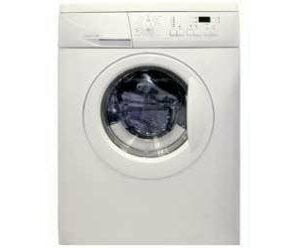
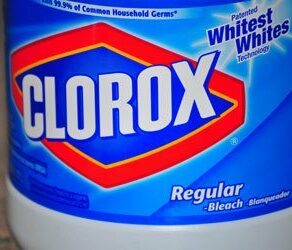
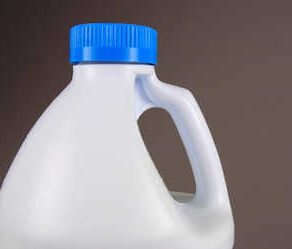

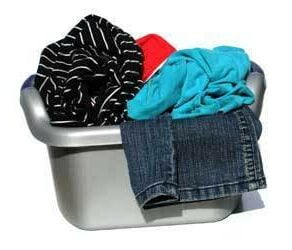


Sorry, but you haven’t answered the original question properly and I have the same issue. People that work in labs of any kind have to be cautious of what they bring home with them, that is a fact and I had a Samsung washer that worked on a completely different method to disinfect clothes than anything out there, but because of several reasons, Samsung stopped making that type and no one else will pick it up. So Pam has a very important question that I have been researching, how to not bring home pathogens, because I have a nine-year-old son with an autoimmune disorder. Basically, heat is the best, but like Pam, if you have dark colors, heat just ruins them too fast.
For a normal washer/dryer, vinegar is the safest (and only) option. Pine Oil won’t do much; grapefruit oil, tea tree oil and pine oil are just what they say…oil! They can do more harm than good on fabric of any kind. Our foremothers had it right; hang it out in the sun to dry! Now, that is wonderful if you have time and sun and it truly is the best, but barring that, white vinegar is the only safe additive that won’t hurt your washer, dryer or your clothes. Basically, you need to get any kind of fabric over the temperature of 130 degrees (give or take) and that means damaging hot water that will fade your clothes as well as shrink them fast. Bleach is fine for white, cotton fabrics, including underwear, but not even color-safe bleach will do much for “scrubs,” “lab coats,” and other medical clothing.
If you have dark colors and you need to have them sanitized as badly as we do, try to invest in a washer that will give you bursts of steam and will have a cold water cycle that really works. LG is the best at this date. Kenmore is made by LG. Samsung (my personal choice for too many things that I admit; I should be buying USA products) is coming out with a new line that should be out in larger cities as we speak. Please be careful what model you buy of any HE washer because you want two things when spending that kind of money for everyone…an “allergen cycle” or a “sanitizing cycle” that will work with cold water and you want one that will allow you to leave your load in the washer without other things forming until you put it in the dryer. As a rule of thumb, you really do want to get them in a dryer ASAP.
For those of us that are in labs and don’t make what a doctor makes and don’t want to spend a fortune on scrubs, vinegar is the only answer right now. I will admit that I haven’t researched or tried Shacklee’s product and I am going to get some ASAP to see what it has to offer. Vinegar also offers an additional boost to your dark colored clothes. It sets the dye so they don’t fade or the colors don’t run. About a cup in with the load will do a full load. Also, the more water you use, the better, so set the load on high even if you don’t have a full load.
What happened to those nice days of not worrying about clothes washing, and everything was “wash and wear?” Well, they never really existed and we all got clothes that need a higher amount of care so they do stay nicer, longer. Most kids’ clothes do fine in warm water and a hot rinse, but for us people with clothes made of every kind of combinations of fabrics, there isn’t a great choice. They demand cold water, a wash on delicate and a cool dryer. Don’t put petroleum products in your laundry and anything that ends in “oil” happens to be one. It will mess up your more delicate clothes and really mess up your washer! I hope I’ve helped someone because we are not getting too “overcautious” about sanitizing. Some situations are not as needy as others, but you don’t want to lie your head on a pillow case full of minor mildew because you did everything right but left it in the washer too long. Then your hair adds all kinds of junk to the mildew, and believe me you don’t want to know what you breathe in every night. Yet jeans and T-shirts will always put up with enough heat to get them clean. It is the stuff you wear next to your body or use next to your body that are the things that are important.
Samsung actually makes and assembles a lot of the washers and dryers they sell right here in the US.
I put my jeans in the freezer over night and they come out with no smells.
I THINK the freezer kills the bacteria. Isn’t that why they keep surgery rooms so chilly?
But I don’t know for sure. I am an artist, not a scientist.
They keep operating rooms so cold because it slows blood circulation.
I simply ran a search on Amazon.com for “Disinfecting laundry detergent” and came up with a few products. They are rather costly and used as an additive to the laundry. I am not sure how safe they are for use with an HE machine though. If you find you will need to disinfect clothing regularly I would highly recommend investing in one of these products. Read all the info about them though, first. I have not purchased any, just looked them up now, because they are too costly. But as I said, it would probably be a good investment for someone working in a field where they are exposed to pathogens and such. My LG washer (I LOVE IT I LOVE IT I LOVE IT) has both allergen and sanitize but wash at high temps. I love that but with things that are “hand wash in cold water only” items? Hmm. With my present economic status, I have found myself hitting the Salvation Army once or twice in search of work clothes, etc. It never used to bother me and a lot of times in the past I never even bothered to wash the stuff I’d bring home, but now I am super conscious about contamination. Anything that comes home goes directly from an airtight tied bag right into a dryer on high for 30-45 minutes, then washed. This leaves me still feeling unsure, though, about things like fungus, viruses, bacteria, etc. I know when dried on high, stuff in my LG dryer gets up to about 160. I am rather surprised that disinfecting laundry products have not really been developed and marketed. Of all the over the top ways they market the anti-germ campaign to OCD Americans who fear germs around their children at home, you’d think where we wash our laundry (generally a very dirty thing) would be the most relevant? People go out into the world, they sit on buses, in seats in public restaurants, etc. I worry more about that than what germs I might catch on my bathroom mirror from sprinkling it by accident with toothpaste from my own mouth. Ever see that commercial? It’s too much.
The FDA draws a very loose line between killing germs and being considered a “pesticide”. If you claim germ killing abilities, you are walking that line. Washer manufacturers are keenly aware of this line and stay away from it. In fact, the Samsung’s SilverCare system DID cross that line when they advertized the germ killing properties of this machine. The Sivercare machines add silver ions during the wash and rinse cycles to maximize the sanitizing and antibiotic effects. Two plates of 99.9% pure silver, a very effective sanitizing agent, are converted into silver ions through electrolysis and penetrate the laundry.
But it turns out, those silver ions kill EVERYTHING in their path from your house, to the local sewer system, to the rivers, lakes and streams.
Not good.
So the EPA sued them and made them make adjustments to the plates and advertising.
Vicki, sorry but tea tree oil is a powerful disinfectant (as is Eucalyptus oil); do the research, it is out there. It does not harm laundry, I use it in every load. I make a mixture of Eucalyptus oil and Tea Tree oil and squirt in the soap dispenser as well as the fabric softener dispenser.
Vicki, there is some really good research out there on GSE (grapefruit seed extract). You should also not confuse essential oils such as tea tree oil with regular “oils,” which are carrier oils. Essential oils are plant extracts using several methods of extraction that retain the immune systems of the plants they are taken from, are very powerful and not to be minimized. GSE is not itself an essential oil, but it is also very powerful in killing germs. This isn’t to suggest that vinegar might not get the job done, but it does not embody an immune system in it, does it? Vinegar might be okay, but it is not going to hold a candle to GSE or tea tree oil.
Vinegar will not kill staph, e. coli or MRSA.
I reiterate what Natural Gal said about oil.
Vicki, do you even know what oil is – you seem to think it can only be petroleum derived! I have an antibacterial magnetic silver ion wash ball in my washing machine, which lasts a really long time and is ridiculously cheap. It’s complicated science though, so you’d need to do some research into the science and particular products and suppliers. They are not readily available in the UK, but tend to be in other parts of Europe where this has caught on. Silver has known antibacterial properties. I wonder if going over clothes with a steam cleaner or garment steamer would have a disinfecting effect; I have read that it does. You can even garment steam silk. Also, the antimicrobial properties of grape seed extract are only derived when it undergoes refining where a chemical is added or some kind of chemical process happens (can’t remember the details), so if you buy it unrefined and cold pressed, it won’t work!
I use Lysol Concentrate and it kills anything. Awesome at getting rid of offensive odors, and effective with vomit stains in laundry. I use a capful for a large load.
I am looking for an alternative to bleach to disinfect colored towels, bedding, etc., in the wash (we have been exposed to a resistant staph infection)… In case anyone owns cats, please note that Lysol is extremely toxic to cats: any residue on counters, clothes, or floors will be absorbed through a cat’s paws or the membranes of their mouths when they routinely lick their fur. It will shut down their kidneys; before we were aware of this fact, a few years ago I unfortunately witnessed two of our Persian cats spontaneously abort within a day after being exposed to the dried floors that had a residue of lysol. I had grown up seeing my mother use Lysol to dissinfect many things in the 1950-60’s. My misguided parents actually used a dilution of Lysol to put on cuts and abrasions when I would fall on my knees as a child.
No one bothered to mention that the original person (Pam) mentioned SPORES, which are very hard to kill. They are a problem in hospitals, where we have access to the most powerful disinfecting products available, so I doubt any of these “home remedies” are going to affect spores.
You need to do your homework. These remedies are only partially effective (or not effective at all).
Concerning the treatment of work clothes which pose a risk of any sort, the employers should arrange at their own cost a reliable means of having the clothing of their employees cleaned and disinfected effectively to avoid the spread of infectious diseases, viral, fungal, whatever. People who are prepared, out of compassion, to work with and care for those who are sick, should not have to endure any extra risk to their own health, or that of family and friends. Neither should they, through no choice of their own, be carrying diseases via contaminated material to the public at large as they make their way from work to home. This is an important health and safety at work issue and should not be ignored.
Completely agree with this. Taking contaminated clothing home is a public health hazard. I would advise anyone who works in healthcare to discuss this issue with admin or your union if you have one. In the meantime I hope you all can find some of these solutions helpful; you don’t need more stress than you already have providing the amazing service you do.
My husband’s dermatologist said that my husband has staph and that his dark shirts must be disinfected. I have always added vinegar to the wash with hypo-allergenic laundry soap. I don’t know if this is actually killing the staph. Any ideas? Thanks.
No, vinegar will not disinfect, especially when diluted with water in the wash and rinse cycles. Tea tree oil will not disinfect.
Pine-Sol also does not contain enough pine oil to disinfect and normal washing with detergent does not kill germs (always thoroughly wash your hands after handling wet laundry).
I’m going to break it down here to avoid the confusion that seems to be going on. The original question is how to disinfect colored clothing in cold water. That’s the nutshell. Colored-clothes…disinfect…cold-water. Please…if one more person talks about heat I’m going to scribble all over this page. Let’s pretend heat doesn’t exist…aaand…GO.
First of all, Pam, when you work at a hospital, you are not allowed to wear your street clothing under your scrubs or lab coat. And you throw the scrubs in the dirty bin every day after your shift. If you follow that, you wont have to worry about contaminated clothing. You should never take your scrubs home with you. Secondly, if you want to disinfect your clothing, use a UV lamp for 15 minutes; that will kill any bacteria or viruses on the clothing.
How long has it been since you worked in a hospital…I know of no hospital that does anything but surgery scrubs laundry… and I have nurses, doctors and radiologists in my family. They are required to buy and wash their scrubs and lab coats. The colors are chosen by department and profession.
Right there with Maia! I have been an RN for 40+ years and the only department to supply scrubs and launder them is Surgical Services. Maybe a rare Emergency Department. Most nurses and other ancillary services are required to purchase, and launder, their own scrubs.
Has anyone noticed that the temperature of the hottest wash water from a new EPA approved wash machine is only around 90 degrees. That’s the mix that is set by the makers to meet the EPA requirements. We had a repair man out twice to see why we could not even get lukewarm water with the temperature on the machine set to hot. He said that is the way they are designed to save energy. If I want hot water to go into my machine, I have to turn off the cold water going in and just have the hot water faucet turned on. I think the EPA is making it impossible to sanitize stuff. No wonder people are getting sick more!
You need to use color safe bleach for dark clothing which works in hot or cold water – temperature is irrelevant. This is basically OXYCLEAN/OXICLEAN.
“I did a little research on the interwebs and found a 39 page thread on diaperswappers.com discussing the use of a vinegar and oxiclean soak for ammonia stink. I figured I had little to lose at this point, so I gave it a shot. Lo and behold, it worked like a charm.
The magic is in vinegar and OxiClean. Apparently, when you combine acetic acid and peroxide, you get peracetic acid– used in industrial applications as a super disinfectant. Vinegar is a weak form of acetic acid and oxiclean is a weak form of peroxide. So when you combine vinegar and oxiclean you get a pretty weak form of peracetic acid. It will foam like crazy– kind of like when you combine vinegar and baking soda– and some people have even said that their’s gets hot (mine never did).”
Courtesy of: http://snickerdoodlesteph.blogspot.com/2010/02/any-cloth-diaperers-in-house.html
Also, you should always use at least warm water if possible and choose the double rinse cycle when washing. Secondly, many HE washers do not use much water, but I have found that you can simply manually add water through the liquid detergent dispenser; I generally add at least 2 gallons of hot water to my wash loads. You need enough water to properly clean clothing; the minimal water cycles do not really get the job done. Even better is a standard washer with a pre-rinse cycle, and I might also add that the enzymes and detergents in a high quality fabric detergent like Tide Ultra Clean are highly effective themselves at removing germs/particles/spores/ etc. Do some research into enzymes and make sure that the detergent you are using has them.
On an HE washer, if you use the bedding cycle it will add way more water so that your clothing is fully saturated and able to spin and mix freely (as long as you haven’t jammed three loads into one). And I am able to put the water temperature to cold. Just a thought.
Sorry, this is incorrect.
Oxyclean’s main ingredient is borax. Sodium perchlorate.
It is highly alkaline.
Conversely, vinegar is an acid.
By mixing them, you are cancelling them both out and rendering them both useless. The reason they foam when mixed is the same reason that baking soda fizzes when you pour it on your battery terminals.
Sibley,
That is not accurate. OxyClean contains sodium percarbonate, not sodium perchlorate. Also, borax is sodium borate, not sodium perchlorate.
Even when acids and bases mix, they still can be effective cleaners. Also, the fizzing that is created acts as a type of scrubber like carbonation or a denture tablet, increasing the effectiveness of the cleaning.
Source: Wikipedia – Borax
Source: Livestrong – Main Ingredients in OxyClean
Source: Wikipedia – Sodium perchlorate
Sorry, but Pine-Sol, vinegar, essential oils, etc. do not kill germs in laundry (especially when diluted by gallons of water).
I’ve just been reading all these posts and was beginning to feel as though life as I knew it was over, given that I can’t effectively hot wash all my laundry. I came onto this website to find out about disinfecting my laundry as I live in a remote area with only limited electricity – solar power and so no heated water supply to my machine. I was feeling buoyant about using some of the natural ingredients until these posts. Now what? I’ve lived here for 12 years! No hot water washing other than soaking my clothes before I wash them in the machine. That means hauling buckets of hot water from the house to the garage…no mean feat at my age. We haven’t suffered any ill-health. My washing dries on the line most days. I love using essential oils and try to live holistically when I can, but, guys, sometimes you just have to hope that the bugs you live with are prepared to co-exist with you and spare you into old age. Maybe I’m in a better position because I’m not living amongst all those germs you all talk about. I feel for you. But if you can get the modern machines and remedies, get them. If you can’t, then trust to nature, do your best and hope.
I have a MRSA stapf infection and in researching EPA approved disinfectants, noticed that Benefect and Pure Green 24 kill MRSA bacteria with low levels of toxicity. Any thoughts on whether or not these products can be used on laundry?
Thanks.
Melaleuca Company (Melaleuca.com) makes a product called Soluguard, which is primarily made out of thyme oil that gets rid of MRSA.
OK I really enjoyed your article. Very informative! I just need to know if using the white vinegar, peroxide, tea tree oil, and bleach all together in one load is safe? If you could get back to me ASAP I would greatly appreciate it! Thank you very much!
Michelle,
First, I am guessing you meant oxygen bleach, not chlorine bleach. Chlorine bleach should never be mixed with other non-laundry products because it is a dangerous chemical and can interact with many different chemicals to create deadly fumes or other hazardous conditions. In particular, chlorine bleach should never be mixed with an acid (such as white vinegar) or with ammonia. For more information on that, see the guide Is It Safe to Mix Cleaning Products with Bleach?
However, oxygen bleach is a completely different bleach and technically, the products you mentioned (if you were referring to oxygen bleach) are safe to mix. In general, it is best not to mix cleaning products ever as a precaution. In this case, the white vinegar and/or hydrogen peroxide could decrease the effectiveness of the oxygen bleach, which works better in a more alkaline environment. The peroxide and vinegar can be used together though, and the tea tree oil should not interact with any other products. However, keep in mind that tea tree oil should never be used on the laundry of children, particularly boys, as it has been shown to interfere with hormones and cause gynecomastia (breast growth) in boys. Good luck!
Source: USP technologies – What is the pH of H2O2 solutions?
Source: Stain Removal 101 – The Ultimate Guide to Oxygen Bleach
Source: RxList – Tea Tree Oil
Grapefruit (Seed) Extract has repeatedly been debunked: GFE / GFSE claims are ABOLUTELY FALSE! Please stop spreading this disinformation. Almost all studies showing efficacy used commercial preps conclusively shown to be contaminated (or deliberately adulterated) with preservatives or other chemicals with well known disinfection properties. Freshly made extracts have almost always failed except for two researchers whose results can’t be replicated.
Hardly definitive itself but easy reading with citations: https://en.wikipedia.org/wiki/Grapefruit_seed_extract
Per a 2012 report (2017 update is more of the same) published
by the American Botanical Council (AKA the Herbal Medicine Institute), a pro alternative medicine source:
“… any observed antimicrobial activity is due to synthetic additives, not the grapefruit seed extract itself. Tests conducted in multiple laboratories over almost 20 years indicated that all commercial GFSE preparations that exhibited antimicrobial activity contained one or more synthetic microbicides/disinfectants, while freshly-prepared extracts of grapefruit seeds made with a variety of extraction solvents neither exhibited antimicrobial activity nor contained the antimicrobial synthetic compounds found in the commercial ingredient materials. Furthermore, over the course of the 18 years covered by the various analyses, the actual antimicrobial compounds found in the putative grapefruit seed extracts changed from triclosan and methyl p-hydroxybenzoate in early samples to benzethonium chloride in the middle years to mixtures of benzalkonium and/or alkonium chlorides in more recent years.”
2012: http://cms.herbalgram.org/herbalgram/issue94/QUALCONTROL_gfse.html
2017: http://cms.herbalgram.org/press/2017/BotanicalAdulterantsBulletinHighlightsthePresenceofSyntheticAntimicrobialCompoundsinGrapefruitSeedExtract.html
Bill,
The article has been updated. Thank you for sharing this information!
Great article. I plan to try the vinegar, borax, and Dr. Bronner’s. With having school-age children, I tried to go on the link to Defense Soap’s Super shield Plus, but couldn’t find the soap you referred to. Please advise if that is the correct link. Thanks.
Chemisse,
The link looks like it moved; it’s updated now though. Thanks for letting us know!
I’m a normal housewife and have read all the above article, but anything above 40 degrees seems to make most synthetic materials like underwear shrink. So what am I going to do now? We are centigrade in SA.
This is one of the most confusing discussions ever!!!